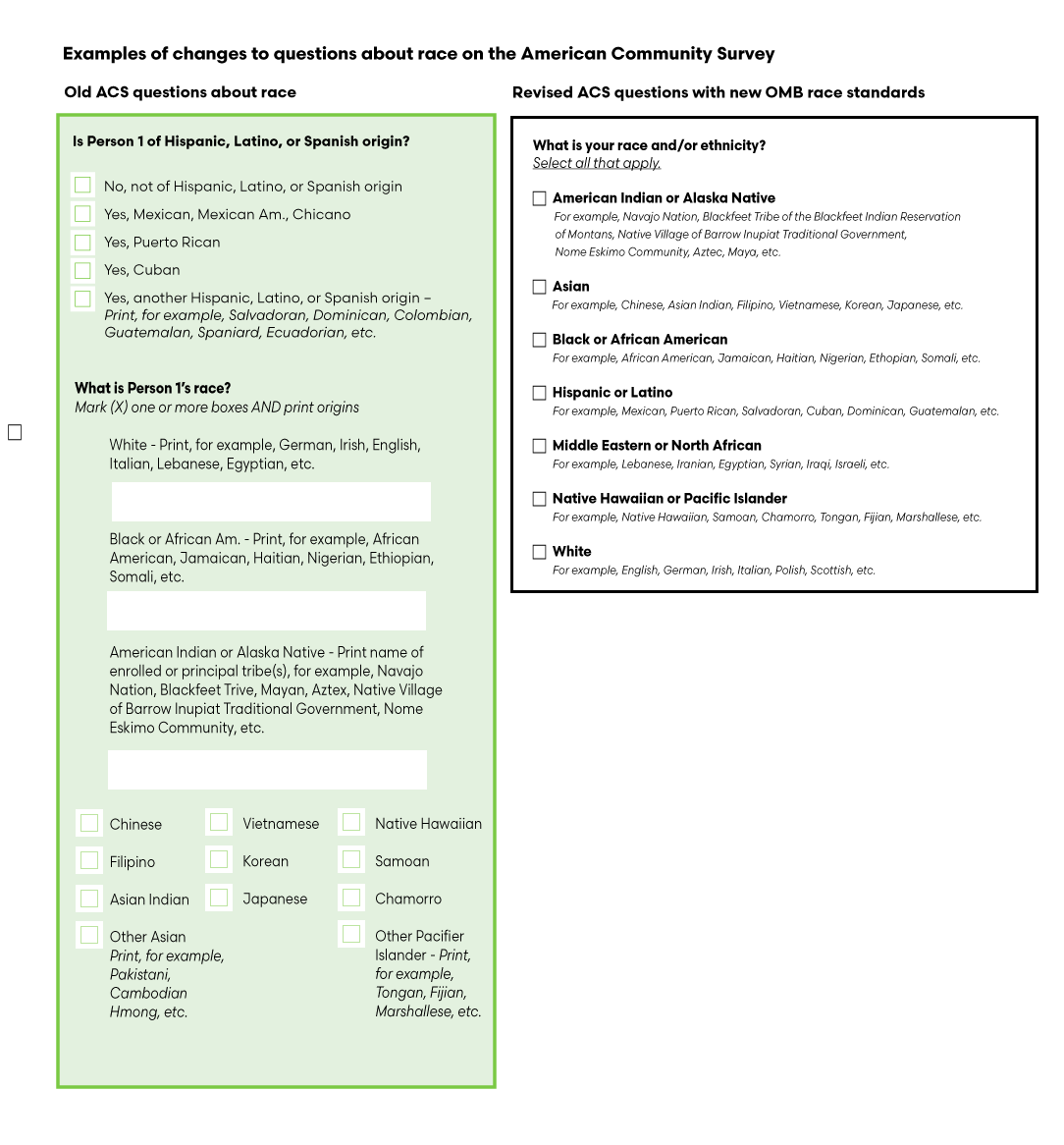For the first time in more than two decades, Minnesota is about to get more accurate data on the racial and ethnic makeup of our population. Recent revisions to the Office of Management and Budget (OMB) Statistical Policy Directive No. 15 represent a significant development in how federal data on race and ethnicity are collected, maintained, and presented[1]. These changes, the first since 1997, are set to improve the way we understand and serve our communities.
Minnesota Compass relies on such data to help community leaders and policymakers better understand the strengths, needs, and quality of life of diverse groups in our communities, and the differences and disparities among those groups.
Key changes to OMB standards
In spring 2024, OMB announced a set of revisions to its race and ethnicity data collection standards. These changes include several pivotal updates aimed at improving how we count and what we know about our diverse populations:
- Combined question format: Currently, race and ethnic categories are presented as separate questions (see examples below).
The new standards require a single, combined question for race and ethnicity, allowing respondents to select one or multiple options and providing a clearer picture of their identities. Currently Hispanic/Latino ethnicity is asked separately from race, which leaves many people in the Latino community without a race option that reflects how they see themselves.

- Middle Eastern or North African category: Currently, individuals from Middle Eastern and North African regions are often categorized as "White," which does not accurately represent their unique cultural and social experiences. The new standards require the addition of a new category of "Middle Eastern or North African. Members of this community and data users advocated for the category to better reflect how they see themselves.
- Detailed data collection: In most cases, federal statistical agencies like the U.S. Census Bureau will now be required to collect more detailed information within the minimum racial and ethnic categories. For example, people will be able to identify as not just “Asian” but “Hmong,” or not just “Black” but “Somali.” This change ensures a deeper understanding of various racial and ethnic groups, supporting more effective policy development and program evaluation.
Altogether, this means that federal agencies will be required to collect information on seven minimum race categories (previously five): American Indian or Alaska Native, Asian, Black or African American, Hispanic or Latino, Middle Eastern or North African (MENA), Native Hawaiian or Other Pacific Islander, and White. Any additional (or disaggregated) categories must roll up to those seven groups.
Data disaggregated by race can help to evaluate programs to ensure that they equitably serve the needs of an increasingly diverse population and to monitor compliance with antidiscrimination policies.
Data disaggregated by race can help to ensure that programs and policies fairly and equitably serve the needs of an increasingly diverse population and to monitor compliance with antidiscrimination laws, regulations, and policies.
When to expect the new data (updated November 2024)
Minnesota Compass users can expect to see data collected under the updated OMB standards phased in over the coming years, beginning in 2028. Here are some key dates to remember:
- September 2028: 2027 ACS 1-year estimates will be the first to reflect new standards, introducing the combined race and ethnicity question, the Middle Eastern or North African (MENA) category, and more detailed, disaggregated racial and ethnic data breakdowns.
- December 2028: 2023-2027 ACS 5-year estimates will include a bridging technique to accommodate mixed old and new standards.
- December 2032: 2027-2031 ACS 5-year estimates will be the first fully based on data collected solely under the new standards, marking full integration.
As these releases become available, we’ll update Minnesota Compass data accordingly. This rollout will enable us to provide even more detailed insights into Minnesota’s diverse communities, furthering our commitment to accurate, up-to-date data that supports meaningful community impact.
The benefits of updated standards
These updates align perfectly with our mission at Minnesota Compass. By adopting the new standards, we will be able to provide more detailed, accurate, and representative data to Minnesota’s community leaders and inform policy on the diverse communities they serve. For example, since 2020, Compass has provided data for dozens of Minnesota's detailed cultural communities based on a combination of race, ancestry, birthplace, and parental characteristics. The profiles give users a more detailed view of population subgroups than is readily available from broad race and ethnicity categories. Currently, much of that data come from the “Ancestry” question in the American Community Survey, which is often left blank. The OMB changes will greatly improve the quality of our profiles by allowing more people to specify their racial identity “up front,” giving us a more accurate classification and a fuller picture of who is in each community. We also expect the OMB changes to increase our estimates of the share of Minnesota’s population who are of color, as Latino and MENA Minnesotans who were previously reclassified by the Census Bureau as White get counted more accurately.
Stay tuned for updates on when these new categories will be reflected in our data. For questions or more details, contact Justin Hollis. Thank you for relying on Minnesota Compass for your data needs.
Additional resources
- Data profiles for Minnesota’s detailed cultural communities
- Race data disaggregation: What does it mean? Why does it matter? by Nicole MartinRogers
- “Why aren’t I represented on Compass?” by Anne Li
- Who counts, and how to be counted by Laura Schauben
- The changing categories that U.S. census has used to measure race by Anna Brown, Pew Research Center
[1]
The Office of Management and Budget (OMB) sets minimum race categories for data on race and ethnicity for federal statistics, program administrative reporting, and civil rights compliance reporting. In loose terms, they set standards for federal agencies – like the Census Bureau – on how to collect data on race and ethnicity.
